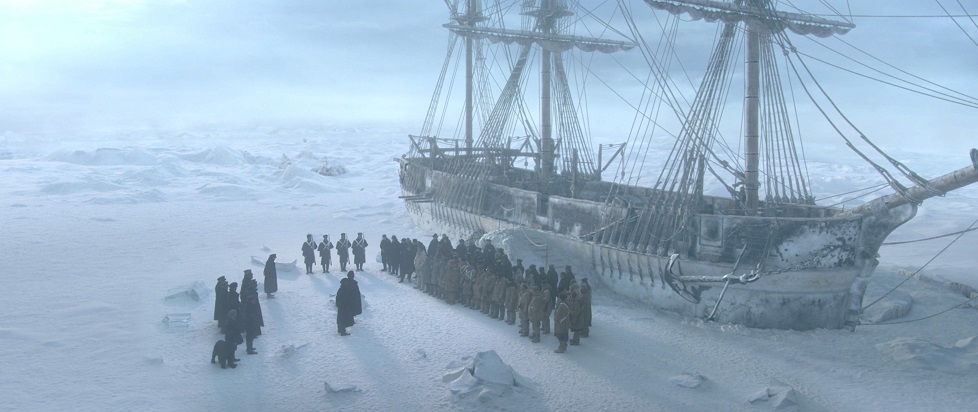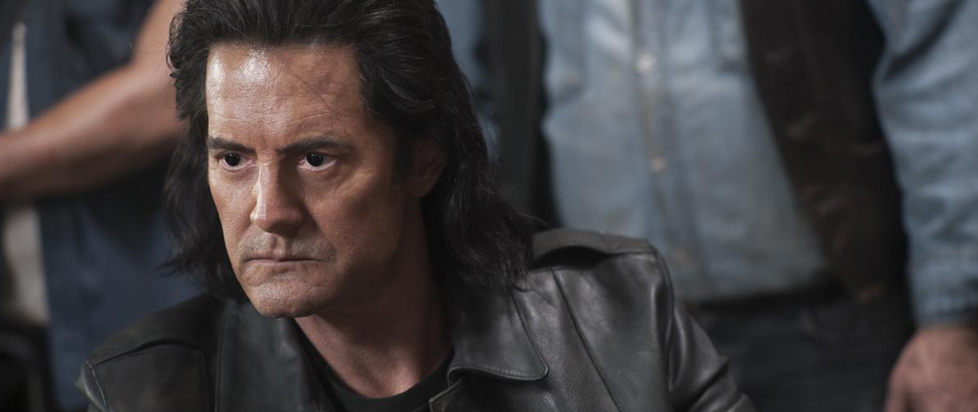
Death Rattles

This column is a reprint from Unwinnable Monthly #105. If you like what you see, grab the magazine for less than ten dollars, or subscribe and get all future magazines for half price.
———-
Three fingers of analysis when two will do.
———
Lots of people can’t stand the sound of nails on a chalkboard. I’ve always hated the crunch of footsteps in snow. The bassy, bitter grit of tiny crystals squeezed and rubbed together rips a pit in my gut that reaches all the way through to the base of my spine. When stepping into a fresh blanket of the stuff, I find myself unconsciously curling my upper body inward in an attempt to, I don’t know, protect my heart? Soothe my stomach? There is something sickeningly satisfying in it, after all – the auditory confirmation that I’m the first to ruin a place. I’m guessing this is why I responded so viscerally to the sound design in AMC’s The Terror.
The show’s inaugural season focuses on Sir John Franklin’s lost expedition to discover the last bit of the Northwest Passage. It tells the tale to the finish and, because of the ready availability of history texts and Wikipedia, relies on careful pacing to elicit its twists and turns. There’s no worrying if these men will die, there’s only the dread of not knowing when. It’s a perfectly contained story told in ten chapters, a smoldering burn that builds to an intense heat – or maybe freeze. At these temps, it’s hard to tell the difference.
For nearly half its run, the men of the HMS Terror and HMS Erebus are trapped ice-locked in their ships. Their perfect and imperfectly inflected speech (rank-dependent, naturally) floats above a foundation of constant creaking shifts and displacement, the ice rearranging itself around the wooden crafts like skin sealing itself over a splinter. Later they make a desperate bid to reach the Canadian mainland on foot, traversing wide beaches of stone. The gravel is large enough to make each of their steps unsteady and they kick stones into stones into stones as they walk, a sound like teeth constantly chattering in an already bare skull. Even when the men stand still, pebbles continue to tumble and settle below the frame. At any given moment in the series, the sustained din of ice and rock creeps into every pause in dialogue, a persistent reminder of the otherworldly landscape just beyond the trappings of Her Majesty’s Naval Service. Nature will have her way, even when the good silver’s on the table.
As masterfully as this technique brings the harsh exterior ever inwards – be it to vessel or camp or soul – it’s outshone by The Terror’s use of silence. For a brief time, the first episode does feature the ships actually moving through water. Before the interminable groaning of settling, stagnant ice, the ambient noise is of wind and waves. Until it isn’t. In an early indication that The Terror is truly a horror story and not just historical reenactment in fancy dress, Sir John Franklin wakes from his sleep with a start, exactly as if someone’s slammed shut his cabin door. It’s not noise that causes his eyes to fly open, however, it’s the distinct lack of any. As he emerges from below decks he turns his back on his handful of officers to look out on the now-still landscape surrounding him. Only we can see his face and for a moment, his mask of leadership slips. The shadow of death passes across his features. The warm, wise, fatherly rear-admiral, a protector truly loved by his men, is afraid.

In another wonderfully intense use of near-silence, a man loses his life. The man who dies sees flashes of the past in between conscious glimpses of the present world spinning wildly in whiteness. He sees the incongruous orange of glowing coals in a brazier set to burn in a frozen world. He sees his own blood marring the pure ice and the deep pit of black that will be his most final destination. In another show, this scene would sound as chaotic as it looks. Here all we get are the muted grunts of an animal and the man’s own small and hesitating cries – he doesn’t have the time to process his experience to a level that would allow them to evolve to full-fledged screams. We hear the brief yet revolting sizzle of flesh meeting heat then a soft splash of faraway water. The man is gone, dead, gone. In the aftermath, we see other men shouting his name but their voices are heavy and distant, as if deep beneath the sea.
Another masterful use of quietness: A man takes the life of his comrade. The man who kills does so in complete and utter silence. He’s fast and feral, stripped to the waist and stabbing another man’s chest and stomach as if he’s a locked-out drunk banging on the door to be let in. There’s no shrieking strings, no squishy fruit as Foley. We’re left without an acoustic way to make sense of the proceedings, precisely as disoriented as his victim.
This is all to say nothing of the score. In terms of who’s responsible for what in the production needs of a television show or film, score and sound design are often separate departments. Both make up the soundscape as a whole, of course, and I’d be remiss not to mention the genius at work here. Immediately after finishing The Terror, I found a playlist made up of tracks by the show’s late composer, Marcus Fjellström. I listened to it often as I headed to the train for my daily commute home. Fjellström had a knack for composing spare yet evocative tracks that needle efficiently into emotional spaces. On one trek to the subway, I noticed the desiccated carcass of a dead robin at the base of a particularly colorful patch of flowers. The brilliant fuchsia of the daisies belied the annihilation of life beneath, just as the northern lights oppose the harsh, unyielding landscape of the Arctic in The Terror. What a shame we’ve lost Fjellström’s particular talent for aural conjuring.
Even the actors contribute generously to the overall tenor of the show. In a particularly grueling scene, a very well-liked man who’s dying believes his commanding officer to be willfully abandoning him. He tended to his superior when the officer was sick and had the favor returned when he began succumbing to illness himself. The abandonment is not true – his captain has been kidnapped and it’s the other camp survivors who are leaving him – but this man dies believing his caretaker and commander rejects him. The show makes us watch. He claws across the grainy and freezing ground, believing he sees his captain seated at the head of a lavish banquet table, turned away from him and laughing. He cries “Captain!” over and over, the gutters of his voice clattering like stones being endlessly kicked across a beach of bleached bone. I find myself unable to take it, and like any true horror aficionado, I clamp my hands over my ears. It’s too late. In the end, the merciless quiet is all any of us will find. The Terror has already taught me that silence equals death.
———
Sara Clemens thinks too much about things, generally. She runs a site called Videodame and retweets stuff on Twitter @thesaraclemens.




